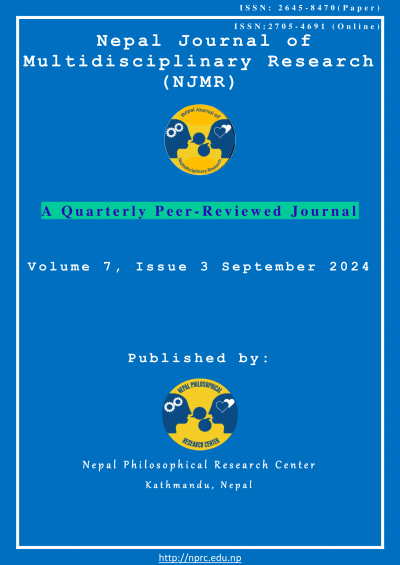Exploring Research Dynamics in Aggression and Violence
DOI:
https://doi.org/10.3126/njmr.v7i3.70928Keywords:
aggression, bibliometric analysis, lens.org, mapping, violence, VOSviewerAbstract
Background: From 1994 to 2023, the research landscape on the subjects of aggression and violence has grown considerably, influenced by a growth in concerns around mental health, the prevention of violence, and cross-disciplinary approaches in the study of human behavior. The rising complexity of such fields requires a bibliometric analysis for an understanding of the thematic trends, key research areas, and scholarly collaborations that have shaped this body of knowledge. Objective: This study attempts to conduct an inclusive bibliometric analysis representing important themes, research trends, and interdisciplinary relationships of scholarship on psychology, aggression, violence prevention, and other public health-related topics in the past three decades. This paper aims at identifying influential topics, authors, and emerging areas of interest as well as shedding light on potential gaps in this research area. Methods: A bibliometric approach has been applied using VOSviewer for network visualization and mapping. The dataset includes scholarly publications in the period between 1994 and 2023; co-authorship, citation analysis, and keyword co-occurrence are included. Major research clusters, prominent authors, and thematic trends identified in this paper represent the main findings in a visual manner. An overview of key topics and their interrelations is shown visually in word clouds and network visualizations. Findings: Results show that psychology is the most dominant discipline in the discourse of aggression, violence, and public health. Dominant topics include mental health, suicide prevention, poison control, and occupational safety. Other fast-growing topics deal with cyber-aggression and media-fueled violence, reflecting technological changes impinging on behavioral studies. There is considerable interdisciplinary interaction, especially between psychology and medicine and/or public health. These three issues do not cover the broadness of research; other areas, such as environmental health and substance abuse, are underrepresented in the scholarship. Conclusion: This bibliometric analysis underlines the role of psychology and public health as significant in addressing aggression, violence, and mental health. The research landscape is large and interdisciplinary, with future research needing to cover environmental, socio-economic, and systemic factors of public health even more. Enhanced interdisciplinary collaboration and embedding of hitherto less explored topics will play a decisive role in the further development of a comprehensive understanding of the complex issues at play. Novelty: The paper therefore carves out a distinctive bibliometric perspective on the evolution of research in psychology, aggression, and violence within the period 1994-2023, pointing not just toward the themes at the forefront, but also the emergent trends and lacunae in the literature. By identifying key areas of scholarly concentration and underrepresented areas, the analysis constructs a roadmap to future research and advances a more integrated approach toward resolving behavioral and public health problems.
Downloads
Downloads
Published
How to Cite
Issue
Section
License
Copyright (c) 2024 The Author(s)

This work is licensed under a Creative Commons Attribution-NonCommercial 4.0 International License.
This license enables reusers to distribute, remix, adapt, and build upon the material in any medium or format for noncommercial purposes only, and only so long as attribution is given to the creator.




